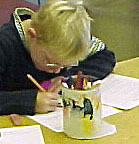
Pollution is something everyone has heard of, but the idea of preventing pollution
before it happens is more abstract and less familiar. Pollution comes from waste.
Prevention of waste before it happens is accomplished through daily, often small,
personal choices (for example, choosing to walk or carpool; buying in bulk to
reduce packaging; using a less hazardous product). Prevention can be difficult
because it involves changing customary or ingrained ways of doing things. For a more
detailed discussion about pollution prevention, see the Pollution Prevention Topic Hub.
Pollution prevention (P2) is the nuts-and-bolts application of what is known
in educational circles as "environmental literacy." According to a
study of K-12 teachers by the North American Association for Environmental Education
and the Environmental Literacy Council,
more than 61% of responding teachers said they included environmental topics
in their curriculum with an average of 115 hours per year spent teaching them.
Recycling and waste management are the most frequently included subjects. The
most common sources of information cited were textbooks (79.1%), the library
(75.9%) and newspapers (74.0%). While discussion is the most frequent method
used to teach environmental topics at all grade levels, hands-on activities/projects
are used by over 90% of K-4 teachers and 80% of 5-8 grade teachers.
The study also reported that prior to becoming teachers only about one in ten
had courses in environmental teaching methods. "Encouraging students to
be active in protecting the environment," was the reason most frequently
given for choosing to include environmental topics and "irrelevancy to
their curriculum" was the reason most frequently given for not including
such topics. "Resistance from parents," "resistance from school
district," and "issues are too controversial" were cited by less
than 1% of the teachers for not teaching about the environment.
However, environmental education that is simply dropped into a curriculum or
program, or that is a series of unconnected experiences, is not true environmental
education, and in the long run, will not promote environmental literacy and
responsible citizenship. The roots of this educational system are found in the
Tbilisi Declaration,
adopted internationally at the first intergovernmental conference on environmental education in 1977.
For a more complete description of Environmental Education see the North American
Association for Environmental Education's Guidelines for Excellence Workbook.
This topic hub provides a collection of multi-disciplinary resources that
go beyond waste management and recycling to address prevention of pollution.
They are presented in this "hub" format so they can be accessed at
any time and wherever an internet connection exists, and so they can be easily
updated as new resources become available. This collection will assist teachers
and youth leaders in preparing pollution prevention-oriented lesson plans for
environmental education. They also provide information and learning activities
for youth and other learners.
The goal of environmental education is to develop a world population that
is aware of and concerned about the environment and its associated problems,
and which has the knowledge, skills, attitudes, motivations, and commitment
to work individually and collectively toward solutions of current problems
and the prevention of new ones.
The Belgrade Charter: A Global Framework for Environmental Education, 1976 |


